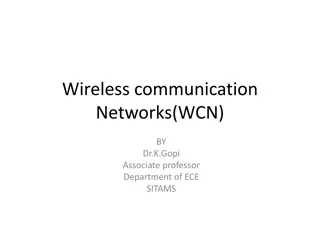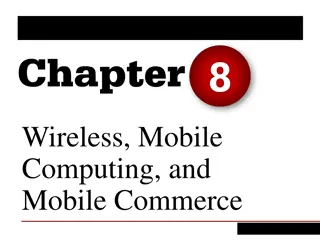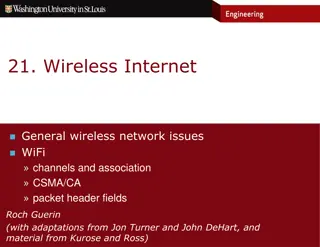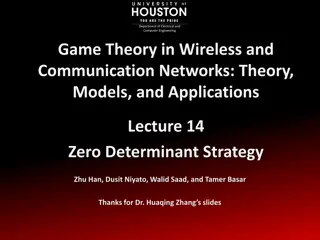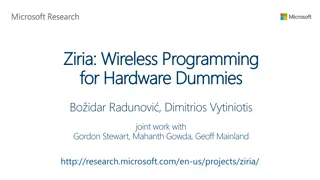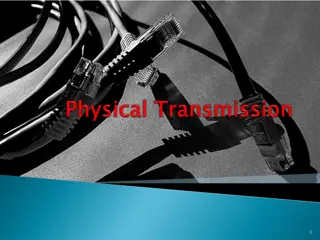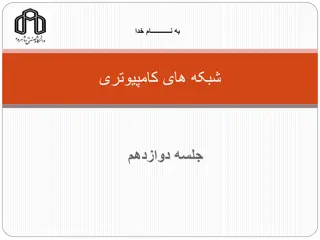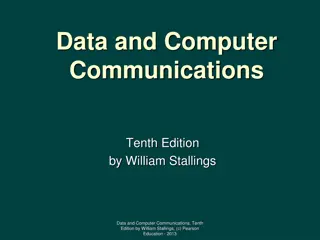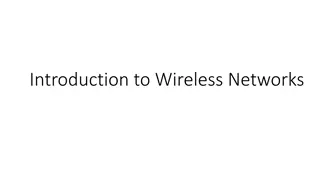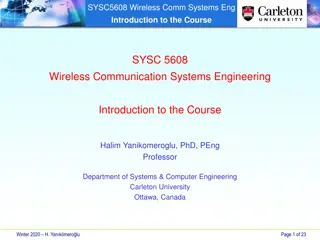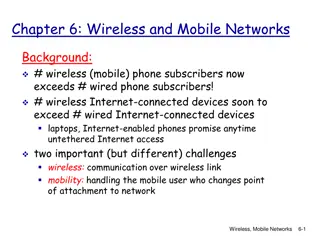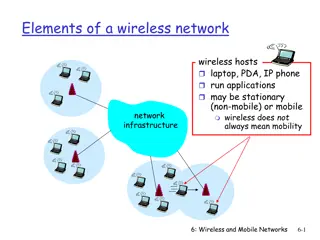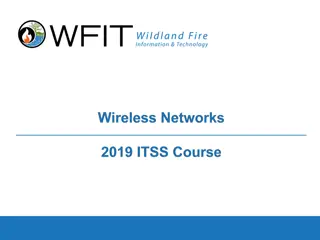Wireless Networks Overview and Challenges
Delve into the world of wireless networks with insights on widespread deployment, properties, links, interference, bit errors, and dealing with high bit-error rates. Understand the limitations, broadcast challenges, and the impact of multi-path propagation on signal quality. Explore the complexities of wireless communication and the strategies employed to counter potential obstacles.
Download Presentation

Please find below an Image/Link to download the presentation.
The content on the website is provided AS IS for your information and personal use only. It may not be sold, licensed, or shared on other websites without obtaining consent from the author.If you encounter any issues during the download, it is possible that the publisher has removed the file from their server.
You are allowed to download the files provided on this website for personal or commercial use, subject to the condition that they are used lawfully. All files are the property of their respective owners.
The content on the website is provided AS IS for your information and personal use only. It may not be sold, licensed, or shared on other websites without obtaining consent from the author.
E N D
Presentation Transcript
1 interWireless Wireless Networks Mike Freedman COS 461: Computer Networks http://www.cs.princeton.edu/courses/archive/spring20/cos461/
2 Widespread Deployment wireless-network-new-4 Worldwide cellular subscribers 1993: 34 million 2005: more than 2 billion 2012: 6.8 billion (2.1B with mobile broadband) >> 1.2B landline subscribers mini-Laptop-Sony-Vaio-Vgn Mobile phone tower Wireless local area networks Wireless adapters built into laptops, tablets, & phones More ubiquitous than wired broadband? 700M in 2012
3 Wireless Links
4 Wireless Properties Interference / bit errors More sources of corruption compared to wired Multipath propagation Signal does not travel in a straight line Broadcast medium All traffic to everyone Power trade-offs Important for power constrained devices
5 Wireless Links: High Bit Error Rate Decreasing signal strength Disperses as it travels greater distance Attenuates as it passes through matter
6 Wireless Links: High Bit Error Rate Interference from other sources Radio sources in same frequency band E.g., 2.4 GHz wireless phone interferes with 802.11b wireless LAN Electromagnetic noise (e.g., microwave oven)
7 Wireless Links: High Bit Error Rate Multi-path propagation Electromagnetic waves reflect off objects Taking many paths of different lengths Causing blurring of signal at the receiver receiver transmitter
8 Dealing With Bit Errors Wireless vs. wired links Wired: most loss is due to congestion Wireless: higher, time-varying bit-error rate Dealing with high bit-error rates Sender could increase transmission power Requires more energy (bad for battery-powered hosts) Creates more interference with other senders Stronger error detection and recovery More powerful error detection/correction codes Link-layer retransmission of corrupted frames
9 Wireless Links: Broadcast Limitations Wired broadcast links E.g., Ethernet bridging, in wired LANs All nodes receive transmissions from all other nodes Wireless broadcast: hidden terminal problem A and B hear each other B and C hear each other But, A and C do not C B So, A and C are unaware of their interference at B A
10 Wireless Links: Broadcast Limitations Wired broadcast links E.g., Ethernet bridging, in wired LANs All nodes receive transmissions from all other nodes Wireless broadcast: fading over distance B A A and B hear each other B and C hear each other But, A and C do not C C s signal strength A s signal strength So, A and C are unaware of their interference at B space
11 Example Wireless Link Technologies Data networks 802.15.1 (Bluetooth): 2.1 Mbps 10 m 802.11b (WiFi): 5-11 Mbps 100 m 802.11a and g (WiFi): 54 Mbps 100 m 802.11n (WiFi): 200 Mbps 100 m 802.16 (WiMax): 70 Mbps 10 km Cellular networks, outdoors 2G: 56 Kbps 3G: 384 Kbps 3G enhanced ( 4G ): 4 Mbps LTE: 10-100 Mbps
12 Wireless Network: Wireless Link Wireless link Typically used to connect mobile(s) to base station Also used as backbone link Multiple access protocol coordinates link access network infrastructure
13 Wireless Network: Wireless Hosts Wireless host Laptop, smartphone Run applications May be stationary (non- mobile) or mobile network infrastructure
14 Wireless Network: Base Station Base station Typically connected to wired network Relay responsible for sending packets between wired network and wireless host(s) in its area network infrastructure E.g., cell towers, 802.11 access points
15 Wireless Network: Infrastructure Network infrastructure Larger network with which a wireless host wants to communicate Typically a wired network network infrastructure Provides traditional network services May not always exist
16 Infrastructure Mode (APs) Infrastructure mode Base station connects mobiles into wired network Network provides services (addressing, routing, DNS) Handoff: mobile changes base station providing connection to wired network network infrastructure
17 Channels and Association Multiple channels at different frequencies Network administrator chooses frequency for AP Interference if channel is same as neighboring AP
18 Channels and Association Multiple channels at different frequencies Network administrator chooses frequency for AP Interference if channel is same as neighboring AP Access points send periodic beacon frames Containing AP s name (SSID) and MAC address Host scans channels, listening for beacon frames Host selects an access point: association request/response protocol between host and AP
19 Mobility Within the Same Subnet H1 remains in same IP subnet IP address of the host can remain same Ongoing data transfers can continue uninterrupted H1 recognizes the need to change H1 detects a weakening signal Starts scanning for stronger one router hub or switch Changes APs with same SSID H1 disassociates from one And associates with other BBS 1 AP 1 AP 2 Switch learns new location Self-learning mechanism H1 BBS 2
20 Questions Loss is primary caused by bit errors (Y) Ethernet (Wired) (M) 802.11 (Wireless) (C) Both (A) Neither All hosts on subnet see all communication (Y) Ethernet (Wired) (M) 802.11 (Wireless) (C) Both (A) Neither
21 Questions Loss is primary caused by bit errors (Y) Ethernet (Wired) (M) 802.11 (Wireless) (C) Both (A) Neither All hosts on subnet see all communication (Y) Ethernet (Wired) (M) 802.11 (Wireless) (C) Both (A) Neither
22 WiFi: 802.11 Wireless LANs
23 802.11 LAN Architecture Access Point (AP) Base station that communicates with the wireless hosts Internet Basic Service Set (BSS) Coverage of one AP AP acts as the master Identified by an network name known as an SSID hub, switch or router AP BSS 1 AP BSS 2 SSID: Service Set Identifier
24 CSMA: Carrier Sense, Multiple Access Multiple access: channel is shared medium Station: wireless host or access point Multiple stations may want to transmit at same time Carrier sense: sense channel before sending Station doesn t send when channel is busy To prevent collisions with ongoing transfers But, detecting ongoing transfers isn t always possible B A C C C s signal strength A s signal strength B A space
25 CA: Collision Avoidance, Not Detection Collision detection in wired Ethernet Station listens while transmitting Detects collision with other transmission Aborts transmission and tries sending again Problem #1: cannot detect all collisions Hidden terminal problem Fading
26 CA: Collision Avoidance, Not Detection Collision detection in wired Ethernet Station listens while transmitting Detects collision with other transmission Aborts transmission and tries sending again Problem #1: cannot detect all collisions Hidden terminal problem Fading Problem #2: listening while sending Strength of received signal is much smaller Expensive to build hardware that detects collisions So, 802.11 does collision avoidance, not detection
27 Hidden Terminal Problem A B C A and C can t see each other, both send to B Occurs b/c 802.11 relies on physical carrier sensing, which is susceptible to hidden terminal problem
28 Virtual carrier sensing First exchange control frames before transmitting data Sender issues Request to Send (RTS), incl. length of data Receiver responds with Clear to Send (CTS) If sender sees CTS, transmits data (of specified length) If other node sees CTS, will idle for specified period If other node sees RTS but not CTS, free to send
29 Hidden Terminal Problem A B C A and C can t see each other, both send to B RTS/CTS can help Both A and C would send RTS that B would see first B only responds with one CTS (say, echoing A s RTS) C detects that CTS doesn t match and won t send
30 Exposed Terminal Problem A B C D B sending to A, C wants to send to D As C receives packets, carrier sense would prevent it from sending to D, even though wouldn t interfere RTS/CTS can help C hears RTS from B, but not CTS from A C knows it s transmission will not interfere with A C is safe to transmit to D
31 Impact on Higher-Layer Protocols Wireless and mobility change path properties Wireless: higher packet loss, not from congestion Mobility: transient disruptions, and changes in RTT Logically, impact should be minimal Best-effort service model remains unchanged TCP and UDP can (and do) run over wireless, mobile But, performance definitely is affected TCP treats packet loss as a sign of congestion TCP tries to estimate the RTT to drive retransmissions TCP does not perform well under out-of-order packets Internet not designed with these issues in mind
32 Questions RTS/CTS more like: (Y) Statistical multiplexing (M) Time-division multiplexing (C) Frequency-division multiplexing Which of following is NOT true? (Y) Collisions are minimized when RTS/CTS used. (M) Sender can always detect a collision without feedback from receiver. (C) TCP congestion control works poorly in wireless without link-layer retransmission. (A) Wireless generally has higher loss rates than wired.
33 Questions RTS/CTS more like: (Y) Statistical multiplexing (M) Time-division multiplexing (C) Frequency-division multiplexing Which of following is NOT true? (Y) Collisions are minimized when RTS/CTS used. (M) Sender can always detect a collision without feedback from receiver. (C) TCP congestion control works poorly in wireless without link-layer retransmission. (A) Wireless generally has higher loss rates than wired.
34 Bluetooth: 802.15.1 personal-area-networks
35 Bluetooth piconets Up to 7 slave devices and 225 parked devices Operates on unlicensed wireless spectrum How to prevent interference?
36 PHY: Spread Spectrum Frequency Hopping Nodes rapidly jump between frequencies Sender and receiver coordinated in jumps How coordinate? Pseudorandom number generator, with shared input known to sender/receiver If randomly collide with other transmitted, only for short period before jump again Bluetooth 79 frequencies, on each frequency for 625 microseconds Each channel also uses TDMA, with each frame taking 1/3/5 consecutive slots. Only master can start in odd slot, slave only in response
37 Infrastructure vs. Ad Hoc Infrastructure mode Wireless hosts are associated with a base station Traditional services provided by the connected network E.g., address assignment, routing, and DNS resolution Ad hoc networks Wireless hosts have no infrastructure to connect to Hosts themselves must provide network services Similar in spirit to the difference between Client-server communication Peer-to-peer communication
38 Conclusions Wireless Already a major way people connect to the Internet Gradually becoming more than just an access network Mobility (not discussed) Today s users tolerate disruptions as they move and applications try to hide the effects Tomorrow s users expect seamless mobility Challenges the design of network protocols Wireless breaks the abstraction of a link, and the assumption that packet loss implies congestion Mobility breaks association of address and location Higher-layer protocols don t perform as well


